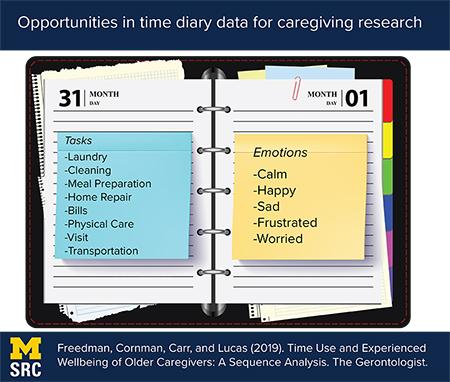May 20, 2019
Opportunities in time diary data for caregiving research
By: Xinyu Zhang
 Previous studies have well documented caregivers for older adults' declined wellbeing. However, most studies use relatively less fine-grained measures that left the role of specific care activities in the daily lives unanswered. In a recent study published in The Gerontologist, SRC researcher Vicki Freedman and her colleagues used time diary data from the 2013 Disability and Use of Time (DUST) supplement to the Panel Study of Income Dynamics (PSID) to explore patterns of informal caregiving and experienced wellbeing over the day.
Previous studies have well documented caregivers for older adults' declined wellbeing. However, most studies use relatively less fine-grained measures that left the role of specific care activities in the daily lives unanswered. In a recent study published in The Gerontologist, SRC researcher Vicki Freedman and her colleagues used time diary data from the 2013 Disability and Use of Time (DUST) supplement to the Panel Study of Income Dynamics (PSID) to explore patterns of informal caregiving and experienced wellbeing over the day.
The measures in most studies of caregiving are not perfect. For example, respondents were typically asked to answer yes/no or to recall the number of hours in a typical week or month. These ways of measuring time spent on caregiving fail to capture precisely how time is spent on each task throughout the day. In addition, decontextualized wellbeing measures (e.g., ask respondents to recall their overall wellbeing over a reference period) cannot specifically evaluate the impact of caregiving.
Comparing to studies using aggregated measures of time use, the detailed diary data can capture both time use on specific tasks and momentary wellbeing. The diary interview asked about all activities happened on the previous day over a 24-hour period. The authors created ordered indicators of care for each 15-min interval. Caregiving activities were categorized as not care, household care, physical care, visiting/socializing, and transportation. To measure experienced wellbeing, respondents were asked to report how intensely they felt five emotions for up to three randomly selected diary activities.
The study found that caregivers on average spent 2.3 hours per day on caregiving, which is an hour less than global reports of care provided on the prior day with the DUST sample. One possible explanation of this result is social desirability effect; social pressure to over-report socially-favored activities relative to diary measure.
The researchers performed sequence and cluster analysis to characterize type and time of care activity. The result showed participation in care follows a roller-coaster pattern over the day, reaching peaks around mealtimes (10 a.m., 12p.m., and 5 p.m.). Five care types were identified with different intensities and activities. The authors found that 40% of caregivers provided only marginal assistance of about 1 hour per day and 28% provided sporadic assistance with a mix of activities for about 2 hours. Interestingly, marginal assistance providers reported lower experienced wellbeing than sporadic assistance providers. Their innovative work portrayed the patterns of older adults' varying caregiving activities and further explored caregivers' wellbeing.
Vicki Freedman, Jennifer Cornman, Deborah Carr, and Richard Lucas (2019). Time Use and Experienced Wellbeing of Older Caregivers: A Sequence Analysis. The Gerontologist.